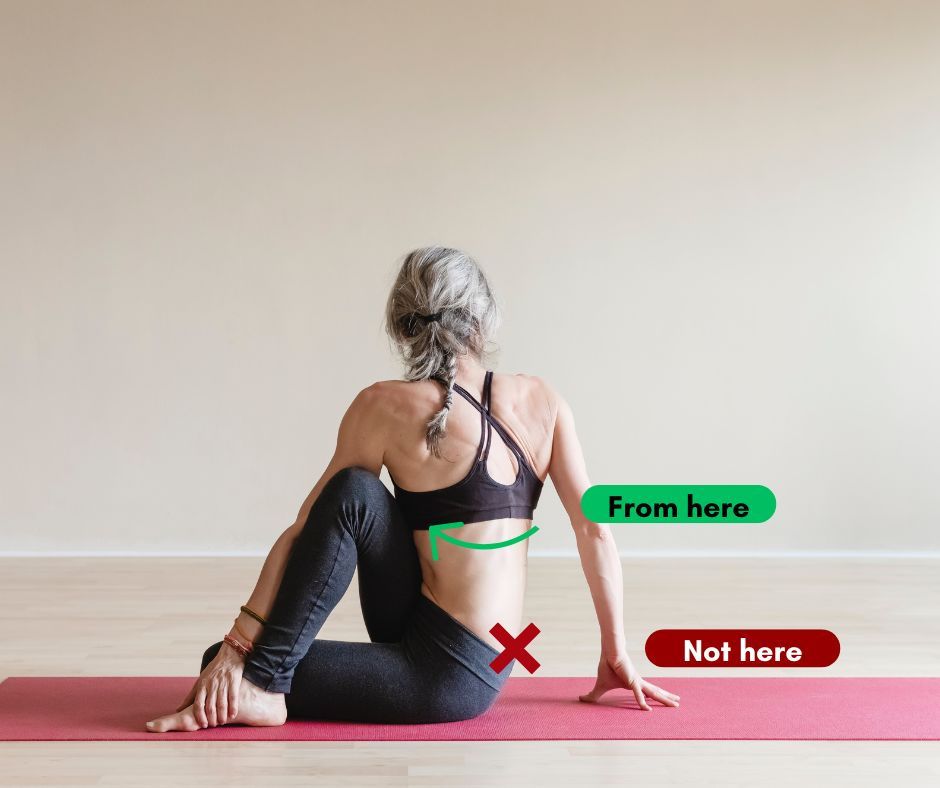Are You Twisting from the Right Place? Safe Spinal Twists for Seniors
- Eryn's Yoga

- Jul 16
- 3 min read

Twists can feel incredible—releasing tension, refreshing the spine, and even creating a subtle inner “reset.” But not all twists are created equal.
One of the most common questions I explore in my own practice and, by extension, with my students is this:
“Are you twisting—or are you torquing?”
The difference? It often comes down to where the movement is coming from.
And for those of us with decades of movement in our bodies, the answer matters more than ever.
Twist 101: The Anatomy of Safe Spinal Twists for SEniors
Your spine isn’t one uniform column—it’s a complex system with different regions built for different kinds of movement:
• Cervical spine (neck): Designed for lots of rotation
• Thoracic spine (mid-back): Meant for rotation—but often underused
• Lumbar spine (low back): Built more for stability than for twisting
Here’s what most people don’t realize:
The thoracic spine can rotate about 35°
The lumbar spine can only rotate about 5–7°—total
So if your twist is coming from the low back?
You’re not rotating—you’re torquing.
So Where Should the Twist Come From?
If we want a twist to be healthy, sustainable, and satisfying, here’s what needs to happen:
1. The pelvis stays neutral or grounded
2. The ribcage rotates over the pelvis—not with it
3. The thoracic spine initiates the movement
4. The spine lengthens upward before rotating
This is the kind of intelligent spinal sequencing that supports not just flexibility—but long-term function.
Twist vs. Torque
Let’s be clear:
A healthy twist is… | A risky torque is… |
Initiated by breath & posture | Forced through leverage |
Guided by spinal architecture | Ignoring joint limitations |
Sustainable and satisfying | Compressive and draining |
Torque happens when we override structure with force.
Twist happens when we align with how the spine is built to move.

Why This Matters More as We Age
As we accumulate years of movement and experience, several things shift:
• Some spinal segments become stiffer from disuse or postural habits
• Other segments become hypermobile, trying to compensate
• Core strength may still be present—but we often recruit the wrong muscles for the job
• The body becomes brilliantly efficient—which means we sometimes take shortcuts without realizing it
This is not about decline.
It’s about how to refine.
Twisting from the right place becomes more important—not because we’re fragile, but because we’re wise enough to move on purpose.
Try This on the Mat
Here’s how to feel the difference in a simple seated twist (like Ardha Matsyendrasana):
1. Ground both sit bones—no tipping, no hip hike
2. Inhale to lengthen the spine
3. Exhale, rotate from the ribcage—not the waist
4. Notice the breath—if it stops, the twist is probably too deep
5. Keep the shoulders easy. Let the eyes follow the twist, not lead it.
You’re not trying to look farther—you’re trying to feel deeper, more clearly.
What This Says About Your Practice
If you care about how your body feels—not just how it looks—you’re already ahead of the curve.
A yoga practice rooted in structure, awareness, and breath isn’t just safer. It’s smarter.
Twisting from the right place:
• Protects the spine
• Sharpens proprioception
• Improves breath capacity
• Keeps movement sustainable across decades—not just today
Because we’re not trying to do yoga like we’re 20.
We’re trying to do yoga so we can still feel amazing at 80.
The Final (ish) Word
Next time you step into a twist, ask yourself:
“Where is this coming from?”
Because how you move matters.
And where you move from? That changes everything.
Want more?
• Join me for mindful movement that meets your body where it is now—and where it’s going.
• Sign up for my newsletter for more insights into safe, science-informed yoga for your future-forward body.
• Follow me on Facebook for weekly tips that celebrate strength, longevity, and movement with meaning.


Comments